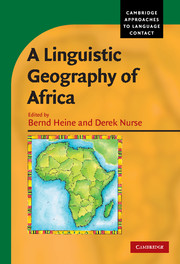Book contents
- Frontmatter
- Contents
- List of maps
- List of figures
- List of tables
- List of contributors
- Series editor's foreword
- Acknowledgments
- Abbreviations
- 1 Introduction
- 2 Is Africa a linguistic area?
- 3 Africa as a phonological area
- 4 Africa as a morphosyntactic area
- 5 The Macro-Sudan belt: towards identifying a linguistic area in northern sub-Saharan Africa
- 6 The Tanzanian Rift Valley area
- 7 Ethiopia
- 8 The marked-nominative languages of eastern Africa
- 9 Africa's verb-final languages
- Notes
- References
- Index
5 - The Macro-Sudan belt: towards identifying a linguistic area in northern sub-Saharan Africa
Published online by Cambridge University Press: 22 September 2009
- Frontmatter
- Contents
- List of maps
- List of figures
- List of tables
- List of contributors
- Series editor's foreword
- Acknowledgments
- Abbreviations
- 1 Introduction
- 2 Is Africa a linguistic area?
- 3 Africa as a phonological area
- 4 Africa as a morphosyntactic area
- 5 The Macro-Sudan belt: towards identifying a linguistic area in northern sub-Saharan Africa
- 6 The Tanzanian Rift Valley area
- 7 Ethiopia
- 8 The marked-nominative languages of eastern Africa
- 9 Africa's verb-final languages
- Notes
- References
- Index
Summary
Introduction
It has been recognized for a long time that languages across a broad sub-Saharan belt from the western end of the continent to the escarpment of the Ethiopian Plateau in the east display certain linguistic affinities. At the same time, it has been difficult to identify precisely the nature and range of these affinities and to provide a plausible explanation for them.
I propose in Güldemann (2003a) that the distribution of logophoric marking in Africa follows an areal pattern in that it is regularly found in languages of the sub-Saharan belt referred to above, but is virtually absent from the rest of the continent. This finding is the starting point for a more systematic investigation of the following questions:
Does this geographical region share other linguistic traits?
If so, do these define some sort of linguistic area?
If so, how has this area come into being?
I present in section 5.2 several linguistic features which appear to share a roughly similar distribution across the African continent, as well as additional candidate features which may support the evidence provided in this chapter. Section 5.3 briefly surveys previous approaches to the general observation of linguistic commonalities across the sub-Saharan belt, among which there is the proposal that most of the languages involved belong to a genealogical lineage comprising Greenberg's super-groups Niger-Kordofanian and Nilo-Saharan.
- Type
- Chapter
- Information
- A Linguistic Geography of Africa , pp. 151 - 185Publisher: Cambridge University PressPrint publication year: 2007
- 87
- Cited by



